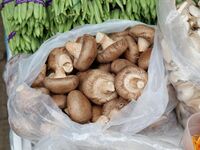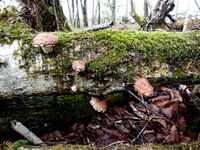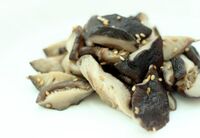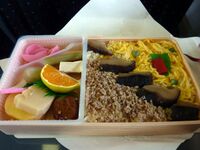Biology:Shiitake
| Shiitake | |
|---|---|

| |
| Scientific classification | |
| Domain: | Eukaryota |
| Kingdom: | Fungi |
| Division: | Basidiomycota |
| Class: | Agaricomycetes |
| Order: | Agaricales |
| Family: | Omphalotaceae |
| Genus: | Lentinula |
| Species: | L. edodes
|
| Binomial name | |
| Lentinula edodes (Berk.) Pegler (1976)
| |
| Lentinula edodes | |
|---|---|
| Mycological characteristics | |
| gills on hymenium | |
| cap is convex | |
| hymenium is free | |
| stipe is bare | |
| spore print is white to buff | |
| ecology is saprotrophic | |
| edibility: choice | |
| Shiitake |
|---|
The shiitake (alternate form shitake) (/ʃɪˈtɑːkeɪ, ˌʃiːɪ-, -ki/;[1] Japanese: [ɕiꜜːtake] (![]() listen) Lentinula edodes) is an edible mushroom native to East Asia, which is cultivated and consumed around the globe. It is considered a medicinal mushroom in some forms of traditional medicine.[citation needed]
listen) Lentinula edodes) is an edible mushroom native to East Asia, which is cultivated and consumed around the globe. It is considered a medicinal mushroom in some forms of traditional medicine.[citation needed]
Taxonomy
The fungus was first described scientifically as Agaricus edodes by Miles Joseph Berkeley in 1877.[2] It was placed in the genus Lentinula by David Pegler in 1976.[3] The fungus has acquired an extensive synonymy in its taxonomic history:[4]
- Agaricus edodes Berk. (1878)
- Armillaria edodes (Berk.) Sacc. (1887)
- Mastoleucomychelloes edodes (Berk.) Kuntze (1891)
- Cortinellus edodes (Berk.) S.Ito & S.Imai (1938)
- Lentinus edodes (Berk.) Singer (1941)
- Collybia shiitake J.Schröt. (1886)
- Lepiota shiitake (J.Schröt.) Nobuj. Tanaka (1889)
- Cortinellus shiitake (J.Schröt.) Henn. (1899)
- Tricholoma shiitake (J.Schröt.) Lloyd (1918)
- Lentinus shiitake (J.Schröt.) Singer (1936)
- Lentinus tonkinensis Pat. (1890)
- Lentinus mellianus Lohwag (1918)
The mushroom's Japanese name shiitake (椎茸) is composed of shii (椎 Castanopsis), for the tree Castanopsis cuspidata that provides the dead logs on which it is typically cultivated, and take (茸, "mushroom").[5] The specific epithet edodes is the Latin word for "edible".[6]
It is also commonly called "sawtooth oak mushroom", "black forest mushroom", "black mushroom", "golden oak mushroom", or "oakwood mushroom".[7]
Distribution and habitat
Shiitake grow in groups on the decaying wood of deciduous trees, particularly shii and other chinquapins, chestnut, oak, maple, beech, sweetgum, poplar, hornbeam, ironwood, and mulberry. Its natural distribution includes warm and moist climates in Southeast Asia.[5]
Cultivation
The earliest written record of shiitake cultivation is seen in the Records of Longquan County (龍泉縣志) compiled by He Zhan (何澹) in 1209 during the Song dynasty in China.[8] The 185-word description of shiitake cultivation from that literature was later cross-referenced many times and eventually adapted in a book by a Japanese horticulturist Satō Chūryō (佐藤中陵) in 1796, the first book on shiitake cultivation in Japan.[9] The Japanese cultivated the mushroom by cutting shii trees with axes and placing the logs by trees that were already growing shiitake or contained shiitake spores.[10][11] Before 1982, the Japan Islands' variety of these mushrooms could only be grown in traditional locations using ancient methods.[12] A 1982 report on the budding and growth of the Japanese variety revealed opportunities for commercial cultivation in the United States.[13]
Shiitake are widely cultivated worldwide, contributing about 25% of the total yearly production of mushrooms.[14] Commercially, shiitake mushrooms are typically grown in conditions similar to their natural environment on either artificial substrate or hardwood logs, such as oak.[13][14][15]
Toxicity
Rarely, consumption of raw or slightly cooked shiitake mushrooms may cause an allergic reaction called "shiitake dermatitis", including an erythematous, micro-papular, streaky pruriginous rash that occurs all over the body including face and scalp, appearing about 24 hours after consumption, possibly worsening by sun exposure and disappearing after 3 to 21 days.[16] This effect – presumably caused by the polysaccharide, lentinan[16] – is more common in East Asia,[17] but may be growing in occurrence in Europe as shiitake consumption increases.[16] Thorough cooking may eliminate the allergenicity.[18]
Uses
| Nutritional value per 100 g (3.5 oz) | |
|---|---|
| Energy | 141 kJ (34 kcal) |
6.8 g | |
| Sugars | 2.4 g |
| Dietary fiber | 2.5 g |
0.5 g | |
2.2 g | |
| Vitamins | Quantity %DV† |
| Thiamine (B1) | 2% 0.02 mg |
| Riboflavin (B2) | 18% 0.22 mg |
| Niacin (B3) | 26% 3.88 mg |
| Pantothenic acid (B5) | 30% 1.5 mg |
| Vitamin B6 | 22% 0.29 mg |
| Folate (B9) | 3% 13 μg |
| Vitamin C | 4% 3.5 mg |
| Vitamin D | 3% 0.4 μg |
| Minerals | Quantity %DV† |
| Calcium | 0% 2 mg |
| Iron | 3% 0.4 mg |
| Magnesium | 6% 20 mg |
| Manganese | 10% 0.2 mg |
| Phosphorus | 16% 112 mg |
| Potassium | 6% 304 mg |
| Sodium | 1% 9 mg |
| Zinc | 11% 1.0 mg |
| Other constituents | Quantity |
| Water | 89.7 g |
| Selenium | 5.7 ug |
| |
| †Percentages are roughly approximated using US recommendations for adults. Source: USDA Nutrient Database | |
Fresh and dried shiitake have many uses in East Asian cuisine. In Japan , they are served in miso soup, used as the basis for a kind of vegetarian dashi, and as an ingredient in many steamed and simmered dishes. In Chinese cuisine, they are often sautéed in vegetarian dishes such as Buddha's delight. One type of high-grade shiitake is called donko (冬菇) in Japanese[19] and dōnggū in Chinese, literally "winter mushroom". Another high-grade mushroom is called huāgū (花菇) in Chinese, literally "flower mushroom", which has a flower-like cracking pattern on the mushroom's upper surface. Both of these are produced at lower temperatures.
| Nutritional value per 100 g (3.5 oz) | |
|---|---|
| Energy | 1,238 kJ (296 kcal) |
75.37 g | |
| Sugars | 2.21 g |
| Dietary fiber | 11.5 g |
0.99 g | |
9.58 g | |
| Vitamins | Quantity %DV† |
| Thiamine (B1) | 26% 0.3 mg |
| Riboflavin (B2) | 106% 1.27 mg |
| Niacin (B3) | 94% 14.1 mg |
| Pantothenic acid (B5) | 438% 21.879 mg |
| Vitamin B6 | 74% 0.965 mg |
| Folate (B9) | 41% 163 μg |
| Vitamin C | 4% 3.5 mg |
| Vitamin D | 26% 3.9 μg |
| Minerals | Quantity %DV† |
| Calcium | 1% 11 mg |
| Iron | 13% 1.72 mg |
| Magnesium | 37% 132 mg |
| Manganese | 56% 1.176 mg |
| Phosphorus | 42% 294 mg |
| Potassium | 33% 1534 mg |
| Sodium | 1% 13 mg |
| Zinc | 81% 7.66 mg |
| Other constituents | Quantity |
| Water | 9.5 g |
| Selenium | 46 ug |
| |
| †Percentages are roughly approximated using US recommendations for adults. Source: USDA Nutrient Database | |
Nutrition
In a 100-gram (3 1⁄2-ounce) reference serving, raw shiitake mushrooms provide 141 kilojoules (34 kilocalories) of food energy and are 90% water, 7% carbohydrates, 2% protein and less than 1% fat. Raw shiitake mushrooms contain moderate levels of some dietary minerals.
Like all mushrooms, shiitakes produce vitamin D2 upon exposure of their internal ergosterol to ultraviolet B (UVB) rays from sunlight or broadband UVB fluorescent tubes.[20][21]
Gallery
Lentinan, a beta-glucan isolated from the shiitake mushroom
References
- ↑ Wells, John C. (2008), Longman Pronunciation Dictionary (3rd ed.), Longman, ISBN 9781405881180
- ↑ Berkeley MJ. (1877). "Enumeration of the fungi collected during the Expedition of H.M.S. 'Challenger', 1874–75. (Third notice)". Botanical Journal of the Linnean Society 16 (89): 38–54. doi:10.1111/j.1095-8339.1877.tb00170.x. https://zenodo.org/record/1433039.
- ↑ Pegler D. (1975). "The classification of the genus Lentinus Fr. (Basidiomycota)". Kavaka 3: 11–20.
- ↑ "GSD Species Synonymy: Lentinula edodes (Berk.) Pegler". Species Fungorum. CAB International. http://www.speciesfungorum.org/GSD/GSDspecies.asp?RecordID=316467.
- ↑ 5.0 5.1 Wasser S. (2004). "Shiitake (Lentinula edodes)". Encyclopedia of Dietary Supplements. CRC Press. pp. 653–64. ISBN 978-0-8247-5504-1. https://books.google.com/books?id=Sfmc-fRCj10C&pg=PA653.
- ↑ Halpern GM. (2007). Healing Mushrooms. Square One Publishers. p. 48. ISBN 978-0-7570-0196-3. https://books.google.com/books?id=FlrpouUh740C&pg=PA48.
- ↑ Stamets, P. (2000). Growing Gourmet and Medicinal Mushrooms (3rd ed.). Berkeley, California: Ten Speed Press. p. 260. ISBN 978-1-58008-175-7.
- ↑ "Error: no
|title=specified when using {{Cite web}}" (in zh). Yuwang jituan. http://hnywzy.com/news_show.asp?id=1829. - ↑ Miles PG; Chang S-T. (2004). Mushrooms: Cultivation, Nutritional Value, Medicinal Effect, and Environmental Impact. CRC Press. p. 241. ISBN 978-0-203-49208-6. https://books.google.com/books?id=XO4EGzpp1M0C&pg=PA241.
- ↑ Tilak, Shantanu (2019). "The Shiitake Mushroom-A History in Magic & Folklore". The Mycophile 59 (1): 1, 4. https://namyco.org/docs/MycophileJanFef2019.pdf.
- ↑ Przybylowicz, Paul; Donoghue, John (1988). Shiitake Growers Handbook: The Art and Science of Mushroom Cultivation. Dubuque, Iowa: Kendall/Hunt. pp. 3–6. ISBN 978-0-8403-4962-0. https://archive.org/details/shiitakegrowersh00przy.
- ↑ (in en) Mushroom Newsletter for the Tropics: The Official Publication of the International Mushroom Society for the Tropics. International Mushroom Society for the Tropics. 1980. https://books.google.com/books?id=ci4NAQAAMAAJ&q=ancient+method+for+shiitake+growing.
- ↑ 13.0 13.1 Leatham GF. (1982). "Cultivation of shiitake, the Japanese forest mushroom, on logs: A potential industry for the United States". Forest Products Journal 32 (8): 29–35. http://128.104.77.228/documnts/pdf1982/leath82a.pdf. Retrieved 21 July 2010.
- ↑ 14.0 14.1 Vane CH. (2003). "Monitoring decay of black gum wood (Nyssa sylvatica) during growth of the Shiitake mushroom (Lentinula edodes) using diffuse reflectance infrared spectroscopy". Applied Spectroscopy 57 (5): 514–517. doi:10.1366/000370203321666515. PMID 14658675. Bibcode: 2003ApSpe..57..514V.
- ↑ Vane CH; Drage TC; Snape CE. (2003). "Biodegradation of oak (Quercus alba) wood during growth of the Shiitake mushroom (Lentinula edodes): A molecular approach". Journal of Agricultural and Food Chemistry 51 (4): 947–956. doi:10.1021/jf020932h. PMID 12568554.
- ↑ 16.0 16.1 16.2 Boels D; Landreau A; Bruneau C; Garnier R; Pulce C; Labadie M; de Haro L; Harry P. (2014). "Shiitake dermatitis recorded by French Poison Control Centers – New case series with clinical observations". Clinical Toxicology 52 (6): 625–8. doi:10.3109/15563650.2014.923905. PMID 24940644.
- ↑ Hérault M; Waton J; Bursztejn AC; Schmutz JL; Barbaud A. (2010). "Shiitake dermatitis now occurs in France". Annales de Dermatologie et de Vénéréologie 137 (4): 290–3. doi:10.1016/j.annder.2010.02.007. PMID 20417363.
- ↑ Welbaum GE. (2015). Vegetable Production and Practices. CAB International. p. 445. ISBN 978-1-78064-534-6. https://books.google.com/books?id=zq4tBgAAQBAJ&pg=PA445.
- ↑ Chang TS; Hayes WA. (2013). The Biology and Cultivation of Edible Mushrooms. Elsevier Science. p. 470. ISBN 978-1-4832-7114-9. https://books.google.com/books?id=-yngBAAAQBAJ&pg=PA470.
- ↑ Ko JA; Lee BH; Lee JS; Park HJ. (2008). "Effect of UV-B exposure on the concentration of vitamin D2 in sliced shiitake mushroom (Lentinus edodes) and white button mushroom (Agaricus bisporus)". J Agric Food Chem 50 (10): 3671–3674. doi:10.1021/jf073398s. PMID 18442245.
- ↑ Cardwell, Glenn; Bornman, Janet F.; James, Anthony P.; Black, Lucinda J. (2018-10-13). "A Review of Mushrooms as a Potential Source of Dietary Vitamin D" (in en). Nutrients 10 (10): 1498. doi:10.3390/nu10101498. PMID 30322118.
External links
 Media related to Lentinula edodes at Wikimedia Commons
Media related to Lentinula edodes at Wikimedia Commons
Wikidata ☰ Q320999 entry
 |







